A lovely decorative dog, in the history of which was a period of life in the monasteries of Tibet, is a Tibetan spaniel. Interesting appearance (see photo), sharp mind and wit, activity and love of life - this is the description of this cute pet. Feeding and content, a description of the appearance and nature, the price of dogs of this breed - these are the questions to which you need to know the answers to the future owner.
The history of spaniels from Tibet
Little is known about the origin of Tibetan spaniels. It is believed that they for centuries lived in the monasteries of Tibet and in every possible way helped the monks: they protected the possessions and participated in religious sacraments.
There are several versions that tell about who is the ancestor of dogs of this breed. Some researchers suggest that this is also. Others believe that it is the Tibetan spaniel that is the progenitor of Pekingese. One is undeniable - a Tibetan spaniel is like a Pekingese dog. And in most cases only experienced dog breeders, having looked at the photos of a Tibetan spaniel, will not be called Pekingese.
In the XIX century, the Tibetan spaniel begins to conquer Europe. Popularity and fame comes after the war, 1945. Despite the fact that the history of the breed totals several centuries, it is officially recognized only in 1988.
Tibetan Spaniel: description of the breed
A photo of a Tibetan spaniel shows us a small decorative dog. She has a short muzzle, and her jaw slightly protrudes forward. The growth of the male is usually not more than 27 cm, the bitches - 24 cm. The weight of the animal is from 4 to 7 kilograms. The forelimbs of the dogs are slightly twisted; tail fluffy, bent into a ring.
The description of the pet will be incomplete, if you do not mention his coat. It is really luxurious, the undercoat is thick, it forms a collar on the neck, and is scratched on the ears and paws (see photo). The wool is silky to the touch, it looks magnificent. Color can be any - the standard of the breed does not impose any restrictions.
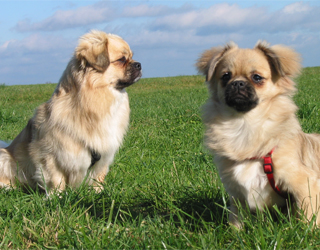
The Tibetan spaniel differs mind, activity, cheerful disposition. He is absolutely not aggressive, it is easy to train. It is necessary to avoid rigor and physical punishment during upbringing.
A Tibetan spaniel dog likes a host and a family, and treats strangers cautiously. A pet needs to be given a personal space.
Features of the content
The dog is unpretentious and does not require special conditions of detention. Animal perfectly get along in the apartment. The main condition - more often and allow the pet to frolic in the fresh air.
Particular attention will need to be given to the animal's coat. It requires daily cleaning with a special brush.
Despite its cute appearance (see photo), a Tibetan spaniel can perform security and watchdog functions. Of course, he will not be able to neutralize the attacker, but to warn about his appearance on his territory is fully capable. It should be noted that a dog of this breed will never bark for nothing.
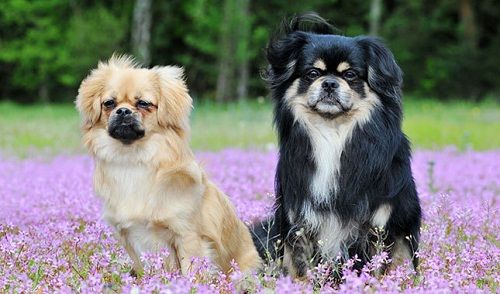
Features of feeding
An important role in the life of the pet plays. From the diet depends on the health, mood and life expectancy of the dog.
Feeding with natural products implies the inclusion in the diet of meat (veal or beef), fermented milk products (low-fat cottage cheese, yogurt or kefir). You can add honey or calcium to food.
The price of a Tibetan spaniel
How to correctly - a question that interests many beginner breeders and amateur breeders. Let's look at the price of puppies, where to buy them and what to look for.
The announcement of the sale can be found in the press, on the Internet at specialized sites or in nurseries. Usually a photo and a description of the puppies are attached to the announcement, the price is indicated. Usually the price is higher for the puppies of the show class (future exhibitors) and the breed class (suitable for further breeding). Significantly lower prices for pets, which for some parameters (usually invisible to the naked eye) are not suitable for exhibitions or breeding of offspring.
The price of dogs of this breed is not the main criterion when choosing a pet. First of all, it is necessary to decide on the gender. Usually the bitches are calmer, besides they will suit the breeders, who plan to breed the tibi in the future.
It is necessary to evaluate the appearance of the puppy, not only from the photo, get acquainted with the breeders, look at the conditions of the animals. Usually puppies are sold at the age of 2 - 2.5 months. They are well-groomed, vaccinated. A healthy pet is distinguished by mobility, curious character and playfulness.

Growth:
Description:
There is no exact information about the origin of the Tibetan spaniel. For the first time, dogs of this breed were found in the 8th century in Tibetan monasteries, where spaniels were turned by prayer drums, which were covered with ritual characters. Purebred Tibetan spaniels could be found only in monasteries: the monks did not recognize the crossing of dogs with other breeds. The ancestors of the breed are the Lhasa Apso and the Tibetan Terrier. It is widely believed that it was from the Tibetan spaniels that the Japanese chin line went - the dogs are very similar in appearance.
Tibetan Spaniels are constantly on the move, regular physical exertion is necessary for them to preserve their health. Tibetan spaniels are prone to violations of the musculoskeletal system, respiratory and cardiovascular systems. Some representatives of this breed suffer from pain in the spine, the cause of which are intervertebral hernias. Also in Tibetan spaniels quite often there is an allergic dermatitis. It is necessary to brush the hair of a Tibetan spaniel daily, and it is also necessary to regularly wipe the dog's eyes. Do not ignore the ears and teeth. In the warm season, the spaniel must be treated with an insecticide-acaricidal agent against fleas, mosquitoes and ticks.
The nature of these dogs is independent, they are very independent, so when raising a puppy, you need not only time, but also patience. His dog and his family members like these dogs very much, but they treat outsiders with suspicion.
FCI Standard # 231:
Characteristics of the breed. An energetic and agile, Tibetan spaniel is good-natured, affectionate and affectionate. He is calm, intelligent, relatively barbaric and not aggressive, but he is not trustworthy towards outsiders, which makes him a good watchman. Needs soft upbringing.
Using. A sentinel dog, a companion dog.
Head. Small. The skull is slightly convex. The transition from forehead to muzzle is not sharp. Muzzle short, lower jaw protruding forward, wide. A full set of teeth is preferred.
Eyes. Medium size, oval in shape, quite widely planted. Dark-brown color, with black edging of the eyelids.
Ears. The average value. Highly planted. Hanging on the cartilage. Covered with long hair.
Housing. Stretched format. The neck is relatively short, sturdy, covered with adorning hair in the form of a mane, is especially pronounced in males. Ribs are convex. The back is straight. Croup is strong.
Extremities. Short, without spread. Paws are small, hare.
Crost. Planted high, usually thrown on the back of the ring. Fluffy.
Hair cover. The coat is of medium length, silky, short and fitting - on the muzzle and the front side of the limbs. On the ears and the back of the limbs - feathers. Undercoat is dense, thin.
Color. All colors and their combinations are allowed.
Height at the withers. Males: about 27 cm.
Bitches: about 24 cm.
In Tibet, very considerate of all dogs. It is believed that after death, any of us can be reincarnated as a dog, and pets can become once human beings. Tibetan spaniels of Buddhists are in special esteem, they are even next to them during prayer, spiritually developing together with their masters. Long ages of these intelligent animals were used to turn the monks into a special prayer drum. In addition, they are still used as vigilant watchmen who from afar see the aliens from the temple wall, and warn monks about it with their sonorous barking.
As soon as the first Europeans saw these animals, they immediately decided to have them at home. There are many versions of when the first Tibetan spaniel came to the West. It is well known that a certain Mrs. McLaren brought such a dog to Britain at the end of the 19th century, made a detailed description of it and showed it at the exhibition in Kraft. During the First World, this breed was almost never disappeared in Europe, but it was preserved. And in 1934 the official standard was approved, which finally eliminated the confusion in the Tibetan breeds of dogs.
Description of breed of dogs Tibetan Spaniel
These creatures are very active, brisk, they listen all the time, trying to catch the slightest rustle in the house. They are small in size, about 25 cm, the average dog's weight does not exceed five kilograms. Ears at them are issued upwards, but freely do not hang out. They are covered with wool, neat and small in size. The muzzle of the Tibetans is slightly flattened, but there are no folds on it. If the mouth of the dog is closed, the teeth are not visible. The back of these creatures is smooth. The tail is covered with thick wool and planted high, usually in the form of a ring on the back. They have very thick and elegant hair. Dogs have a small mane, which the bitches do not have. they are also more dense than the "ladies". Color is completely different - fawn, piebald, mottled, red, bicolour or black. It is noticed that males have a brighter coloring.
Character of the Tibetan Spaniel
Having a small compact size and nice appearance, these are perfect. They are smart and very inquisitive, mobile, have a good nose. But this roomy dog has also watchful qualities, which manifest themselves in distrust of outsiders and vigilance. It is possible that you will have to tinker with a little training, which must be started at an early age. It's all about the independent nature of these pets. But patience and affection with the Tibetans can achieve success. On toddlers you need to work extremely tactfully, without threats and loud cries. That's when the tricks have already been learned, they will gladly show them to the owners or your friends.
Caring for a Tibetan Spaniel
To your pets were in good shape, they need regular loads in the form of jogging in the open air. They have a tendency to have problems with the musculoskeletal apparatus and the respiratory tract. Other common diseases in dogs of this breed are allergic dermatitis and hernia in the spine. When choosing a pet ready food, give preference to quality balanced products, then you will not need to select additional mineral or vitamin supplements. 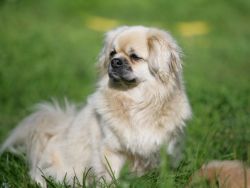
These creatures have a luxurious coat that requires a small but regular care. It is necessary to comb it a couple of times a week, paying attention to those places where it is the longest. Often they do not recommend bathing, but periodically check their ears, eyes and claws are just necessary. This will help you with special antibacterial napkins and cotton swabs. To maintain cleanliness and for safety reasons, it is necessary to periodically inspect the pet's legs and cut the wool between the pads. It prevents walking, and babies can slip because of it. The good loving owners never have much trouble with them.
Behind the Tibetan spaniel the fame of a very intelligent pet is firmly entrenched. And what else can there be a dog that for centuries served in the abode of world wisdom and spiritual science? Today, the Tibetan spaniel is, first of all, a wonderful family dog, an excellent companion and friend, but once this dog lived exclusively in monasteries and was an invariable participant in religious sacraments. In particular, the main mission of this dog was the rotation of the so-called prayer drum - this simple ritual was intended for communication with spirits and purification of the soul of the praying.
It should be said that the monks carefully guarded their spaniels and tried not to allow cross-breedings. If we talk about the origin of these dogs, scientists do not have an unambiguous point of view on this score. According to one of the versions in the formation of the breed of Tibetan spaniels participated "Chinese" shih-tzu and Pekingese. Other researchers tend to believe that, on the contrary, the Tibetan spaniel and pug are the ancestors of Pekingese. In Europe, Tibetan spaniels came in the 19th century, where they gained some fame only after the Second World War. Despite a long history, officially the breed was recognized only recently - in 1988.
Externally, a Tibetan spaniel is a little dog of a slightly elongated format, with a short muzzle, a bulging skull and an outstanding jaw. The growth of an adult spaniel at the withers is usually about 27 cm for males and about 24 cm for bitches, weight - from 4 to 7 kg. This dog is characterized by twisted forelimbs and a fluffy tail, which she holds with a ring on her back.
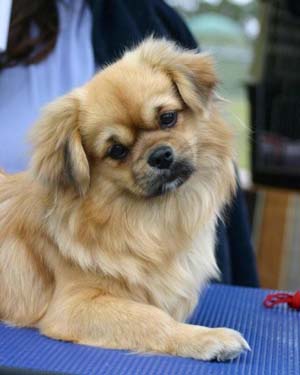 Of course, the main treasure of the Tibetan spaniel is a luxurious coat - lush, silky to the touch, with a thick undercoat, a collar on the neck and feathers on the ears and paws. Of course, when acquiring such a dog, you should understand that her head of hair will certainly require time and attention, but caring for her is not so complicated - you only need to brush your hair daily. On the color of the Tibetan spaniel standard does not impose any restrictions, it can be of almost any shades and combinations.
Of course, the main treasure of the Tibetan spaniel is a luxurious coat - lush, silky to the touch, with a thick undercoat, a collar on the neck and feathers on the ears and paws. Of course, when acquiring such a dog, you should understand that her head of hair will certainly require time and attention, but caring for her is not so complicated - you only need to brush your hair daily. On the color of the Tibetan spaniel standard does not impose any restrictions, it can be of almost any shades and combinations.
So, the Tibetan spaniel is a clever, active and cheerful creature, completely devoid of aggression and perfectly capable of training. This dog is very attached to its owner and family, but with prejudice and distrust refers to strangers. In matters of education of this dog it is important to take into account that excessive rigor will not do her good. The Tibetan spaniel is a self-sufficient creature that can not be deprived of personal space and the right to own opinion.
Perhaps it will surprise you, but the Tibetan spaniel has a strong guarding instinct and can take on some of the functions of a guard dog. Of course, it is unlikely that he could pose a serious threat to the physical health of the attacker, but it is quite capable of threateningly warning a stranger of future troubles if he does not leave the territory. At the same time, which is important, the Tibetan spaniel never barks in vain.
The history of the origin of the Tibetan spaniel still remains a mystery. Some scientists believe that the ancestors of this breed are Pekingese and Shit-tsu. But there is also the opposite opinion - a supposedly Tibetan spaniel in a cross with a pug gave birth to the birth of Pekingese.
The first mention of Tibetan spaniels was found in the 18th century. At that time Tibet was the main breeding place for these dogs. They played the drum with prayers. Selection of dogs for this event was very strict. Animals could not be crossed with other dogs. Changes in the laws of China have changed the course of the Tibetan spaniel. Earlier, the cultivation of these lovely dogs was allowed only within the walls of Tibetan monasteries. Now you can breed these dogs and outside the walls of the sanctuary.
In Europe, a Tibetan spaniel appeared in the 19th century. Most dogs were common in England, and only in the middle of the 20th century did the breed spread to other countries.
Description of the Tibetan Spaniel
 Externally, the dog looks very cute. Head small, muzzle short, jaw slightly protruding forward. The growth of the dog at the withers varies from 24 to 27 cm. The weight - from 4 to 7 kg. Forepaws slightly curved. The paws are short. The back is straight and slightly extended. Neck short, tail fluffy, in the form of a ring. The undercoat is thick, with a beautiful collar around the neck. The wool is soft and lush. The color of the dog can be different. The breed standard in this respect is not limited. The eyes are widely distributed, have an average size and brown color.
Externally, the dog looks very cute. Head small, muzzle short, jaw slightly protruding forward. The growth of the dog at the withers varies from 24 to 27 cm. The weight - from 4 to 7 kg. Forepaws slightly curved. The paws are short. The back is straight and slightly extended. Neck short, tail fluffy, in the form of a ring. The undercoat is thick, with a beautiful collar around the neck. The wool is soft and lush. The color of the dog can be different. The breed standard in this respect is not limited. The eyes are widely distributed, have an average size and brown color.
The dog is intended for living in warm, comfortable conditions. The dog is one of the best companions, a devoted friend and companion. Not aggressive, little barks, good. To outsiders this breed is mistrustful, which makes it a good watchdog. She will not be able to neutralize the attacker, but to report his stay in the house - easily.
The Tibetan spaniel will never bark for no reason. The dog is endowed with a developed intellect. That is why the Tibetan spaniel was chosen by the monks to work in the monastery. The Tibetan spaniel needs gentle gentle upbringing. Very good friends of these dogs with children.
Purpose of the dog:
- Watchdog.
- A companion dog.
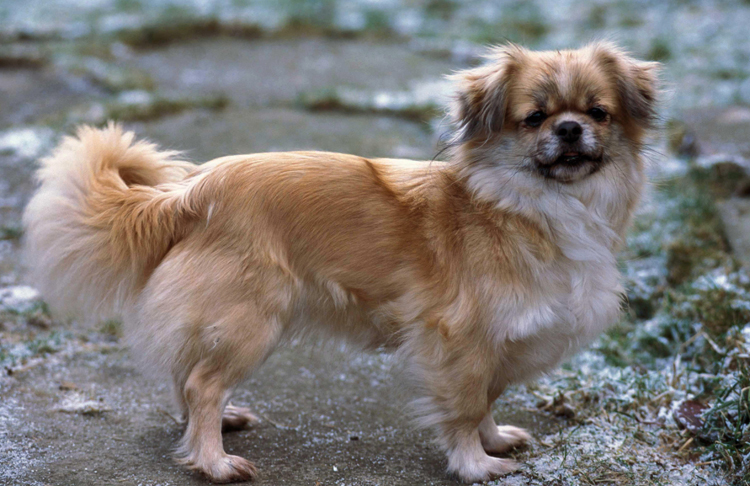
Dog Care
To ensure the health of the Tibetan spaniel was always on top, you should know the rules of pet care. Because of the small size and good nature the dog is well suited for keeping in the apartment. But her curiosity, activity and love of life require a splash of accumulated energy. This breed needs long walks, accompanied by games and running.
Particular attention should be paid to the animal's coat. The dog needs to be combed every day with a special brush. Otherwise, in the wool will be formed koltuny. Do not forget about care for the ears, eyes and claws.
Diseases to which the Tibetan spaniels are inclined
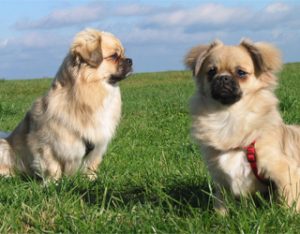 Tibetan Spaniels are prone to diseases of the ears. Checking the auricle should be done at least once a week. If possible, even more often. You need to clean the ears from the accumulated sulfur. You can do cleaning with a cotton pad or cotton swab, but do not need to wet them.
Tibetan Spaniels are prone to diseases of the ears. Checking the auricle should be done at least once a week. If possible, even more often. You need to clean the ears from the accumulated sulfur. You can do cleaning with a cotton pad or cotton swab, but do not need to wet them.
Eyes are also a weak point of the dog. They should be looked after in the same way as behind the ears. Possible eye diseases like conjunctivitis, cataracts. Because of the short nose, problems with the respiratory system are possible.
Dogs are prone to frequent rashes. There are problems with the spine and cardiovascular system.
Tibetan spaniels live quite long, up to 18 years. Such a long life expectancy is achieved due to the genetically sound health of the dog.
Feeding the Tibetan Spaniel
From the proper nutrition of the pet depends on the condition of his hair, claws and overall health. It is necessary to exclude smoked, fried, sweet and fat. Products with a high content of starch and salt also have a bad effect on the health of the dog. Flour and pasta are not useful.
It is worth remembering that the healthy eating of a dog is meat. Especially useful is the use of veal and beef. The choice should fall on low-fat meat. Meat should take 2/3 of the main food.
Puppies Tibetan spaniel is best fed low-fat cottage cheese. A portion of cottage cheese can be diluted with kefir or yoghurt without sugar and fillers. To raise the immunity of the puppy, you can add a small amount of honey. It is especially good to do this during the period of exacerbation of infectious diseases.
Training
Tibetan Spaniels are different wit and ingenuity. They are able to master an impressive number of teams. The nature of training should be gentle and tactful. Once the dog feels that you treat her like an equal, she will happily take part in the training. Puppies of Tibetan spaniels can easily master a whole set of teams.

